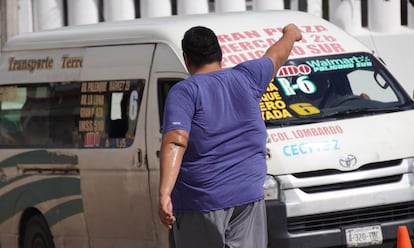Mexico has the second-highest obesity rate in the OECD
The country also has the highest incidence of diabetes, with two in 10 people suffering from the condition, compared to 10% in the United States


In Mexico, almost four out of every 10 people over 15 years of age suffer from obesity. It has the second-highest obesity rate of the countries that make up the Organization for Economic Cooperation and Development (OECD), just six points below the United States (42.8%). The OECD has presented a hard-hitting report that reviews the health outlook for 2023. It found that Mexicans have the highest rate of diabetes, a disease that affects 16.9% of the population.
The deputy head of the OECD health division, Frederico Guanais, has expressed concern about how obesity can impact the Mexican healthcare. “Mexico must take intersectoral action to prevent obesity. With the levels in Mexico, the crisis in the health system is going to worsen,” the expert warned. The OECD said that obesity also affects the Mexican economy, with the health costs of the condition reducing gross domestic product (GDP) by 5.3%.
A person is diagnosed with obesity when their Body Mass Index (BMI) — which is obtained by dividing weight by height squared — is over 30. In Mexico, 36% of people are above that threshold. Together with mortality due to air pollution, obesity is the only risk factor in which the country exceeds the OECD average. Mexicans, however, are below average in liters of alcohol consumed per person (5) and the number of inhabitants who smoke daily (8.6% of the population).
But the OECD is concerned about the rate of type I and II diabetes in Mexico, which is the highest of all OECD countries, and has risen three points. Almost two out of every 10 Mexicans suffer from diabetes, a much higher percentage than in the United States, where the rate is 10%.
The OECD, however, did report that life expectancy in Mexico has risen slightly to 75.4, up from 75.1.
Access to healthcare
Only seven out of 10 people in Mexico had access to the basic healthcare system in 2020, the last year with figures available for the OECD, when the Covid-19 pandemic was taking a heavy toll on the weakened system. The OECD is concerned because in 2019 that figure was 80%.
In addition to the lack of access, the Mexican government’s health spending is the lowest when measured per person. It is only $1,181 per capita, although it has increased by $48 compared to what was invested in 2021.
The number of doctors is up, although it is up only one basis point from the 2.4 per 1,000 inhabitants in 2021. Mexico continues to lag behind Colombia. Also striking is the fact that in Mexico, there is only one hospital bed per 1,000 people, compared to more than 12 in Korea and Japan.
Guanais says that Mexico is facing a “serious problem of health system financing.” On October 10, Mexican President Andrés Manuel López Obrador launched a project to reform the country’s healthcare system. He obtained the signature of 23 of Mexico’s 32 states to centralize healthcare under the federal government, in the IMSS-Bienestar program. The OECD will re-evaluate Mexico’s sector in two years time. This period will be key to determining whether Mexico will be able to improve its healthcare system, which has been lagging behind for years.
Sign up for our weekly newsletter to get more English-language news coverage from EL PAÍS USA Edition
Tu suscripción se está usando en otro dispositivo
¿Quieres añadir otro usuario a tu suscripción?
Si continúas leyendo en este dispositivo, no se podrá leer en el otro.
FlechaTu suscripción se está usando en otro dispositivo y solo puedes acceder a EL PAÍS desde un dispositivo a la vez.
Si quieres compartir tu cuenta, cambia tu suscripción a la modalidad Premium, así podrás añadir otro usuario. Cada uno accederá con su propia cuenta de email, lo que os permitirá personalizar vuestra experiencia en EL PAÍS.
¿Tienes una suscripción de empresa? Accede aquí para contratar más cuentas.
En el caso de no saber quién está usando tu cuenta, te recomendamos cambiar tu contraseña aquí.
Si decides continuar compartiendo tu cuenta, este mensaje se mostrará en tu dispositivo y en el de la otra persona que está usando tu cuenta de forma indefinida, afectando a tu experiencia de lectura. Puedes consultar aquí los términos y condiciones de la suscripción digital.
More information
Archived In
Últimas noticias
Most viewed
- Sinaloa Cartel war is taking its toll on Los Chapitos
- Oona Chaplin: ‘I told James Cameron that I was living in a treehouse and starting a permaculture project with a friend’
- Reinhard Genzel, Nobel laureate in physics: ‘One-minute videos will never give you the truth’
- Why the price of coffee has skyrocketed: from Brazilian plantations to specialty coffee houses
- Silver prices are going crazy: This is what’s fueling the rally










































